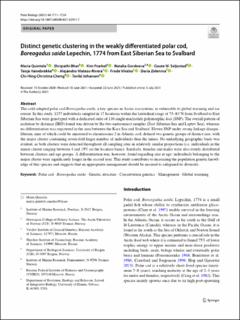| dc.contributor.author | Sanchez, Maria Quintela | |
| dc.contributor.author | Bhat, Shripathi | |
| dc.contributor.author | Præbel, Kim | |
| dc.contributor.author | Gordeeva, Natalia | |
| dc.contributor.author | Seljestad, Gaute Wilhelmsen | |
| dc.contributor.author | Hanebrekke, Tanja Lexau | |
| dc.contributor.author | Mateos-Rivera, Alejandro | |
| dc.contributor.author | Vikebø, Frode Bendiksen | |
| dc.contributor.author | Zelenia, Daria | |
| dc.contributor.author | Cheng, Chi-Hing Christina | |
| dc.contributor.author | Johansen, Torild | |
| dc.date.accessioned | 2021-08-13T12:09:11Z | |
| dc.date.available | 2021-08-13T12:09:11Z | |
| dc.date.created | 2021-07-30T13:55:45Z | |
| dc.date.issued | 2021 | |
| dc.identifier.citation | Polar Biology. 2021, 44 1711-1724. | en_US |
| dc.identifier.issn | 0722-4060 | |
| dc.identifier.uri | https://hdl.handle.net/11250/2767798 | |
| dc.description.abstract | The cold-adapted polar cod Boreogadus saida, a key species in Arctic ecosystems, is vulnerable to global warming and ice retreat. In this study, 1257 individuals sampled in 17 locations within the latitudinal range of 75–81°N from Svalbard to East Siberian Sea were genotyped with a dedicated suite of 116 single-nucleotide polymorphic loci (SNP). The overall pattern of isolation by distance (IBD) found was driven by the two easternmost samples (East Siberian Sea and Laptev Sea), whereas no differentiation was registered in the area between the Kara Sea and Svalbard. Eleven SNP under strong linkage disequilibrium, nine of which could be annotated to chromosome 2 in Atlantic cod, defined two genetic groups of distinct size, with the major cluster containing seven-fold larger number of individuals than the minor. No underlying geographic basis was evident, as both clusters were detected throughout all sampling sites in relatively similar proportions (i.e. individuals in the minor cluster ranging between 4 and 19% on the location basis). Similarly, females and males were also evenly distributed between clusters and age groups. A differentiation was, however, found regarding size at age: individuals belonging to the major cluster were significantly longer in the second year. This study contributes to increasing the population genetic knowledge of this species and suggests that an appropriate management should be ensured to safeguard its diversity. | en_US |
| dc.language.iso | eng | en_US |
| dc.title | Distinct genetic clustering in the weakly differentiated polar cod, Boreogadus saida Lepechin, 1774 from East Siberian Sea to Svalbard | en_US |
| dc.type | Peer reviewed | en_US |
| dc.type | Journal article | en_US |
| dc.description.version | publishedVersion | en_US |
| dc.source.pagenumber | 1711-1724 | en_US |
| dc.source.volume | 44 | en_US |
| dc.source.journal | Polar Biology | en_US |
| dc.identifier.doi | 10.1007/s00300-021-02911-7 | |
| dc.identifier.cristin | 1923155 | |
| dc.relation.project | Equinor: 4590100459 | en_US |
| dc.relation.project | Norges forskningsråd: 314449 | en_US |
| cristin.ispublished | true | |
| cristin.fulltext | original | |
| cristin.qualitycode | 1 | |
